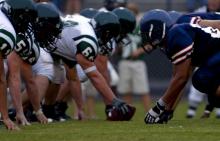The heat is a serious hazard for teenage athletes that each year results in more than 9,000 illnesses nationwide, according to a heat illness analysis from the Centers for Disease Control and Prevention.
Nearly 71% of those heat-related illnesses occurred among high school football players. They experienced time-loss heat illness – dehydration, heat exhaustion, or heat stroke that resulted in at least 1 day of missed sports – about 4.5 times per 100,000 athlete exposures. That rate is 10 times greater than the average rate for eight other common high school sports. Football players also were more likely to experience a heat-related illness if they were overweight or obese. About 37% of high school football players who were affected by the heat were overweight, and nearly 28% were obese, according to the CDC.
The study, which is the first to report national estimates for time-loss heat illness among high school athletes, was published Aug. 19 in the Morbidity and Mortality Weekly Report (MMWR 2010; 59:1009-13). The researchers used information from the National High School Sports-Related Injury Surveillance Study and specifically analyzed data on 100 high schools from 2005 to 2009. The researchers used those data to produce national estimates.
Many high schools begin preseason sports training in August, which appeared to be the worst month for heat-related illnesses among teen athletes: 66% of illnesses occurring in that month. Time-loss heat illnesses also were more likely to occur during practice than competition, although that is likely because teams spend more time practicing in August, the researchers noted.
The heat-loss illness estimates are conservative and might underestimate the risk to teenage athletes, the investigators said, because the data don’t include heat illnesses in which an athlete was cleared to return to practice the next day. The study also was limited to nine sports and included only schools with certified athletic trainers who were affiliated with the National Athletic Trainers’ Association (NATA).
The researchers urged athletes and coaches to heed existing recommendations from NATA for preventing and treating heat-related illnesses. Those include providing a 14-day acclimatization period during warm-weather sports training, in which the frequency, duration, and intensity of training is increased gradually.
NATA also recommends that athletes be educated about heat-related illnesses and the need for proper hydration before, during, and after sports.
Almost 71% of heat-related illnesses reported in a new analysis occurred among high school football players. Photo: Copyright Fred Hall/iStockphoto.com


